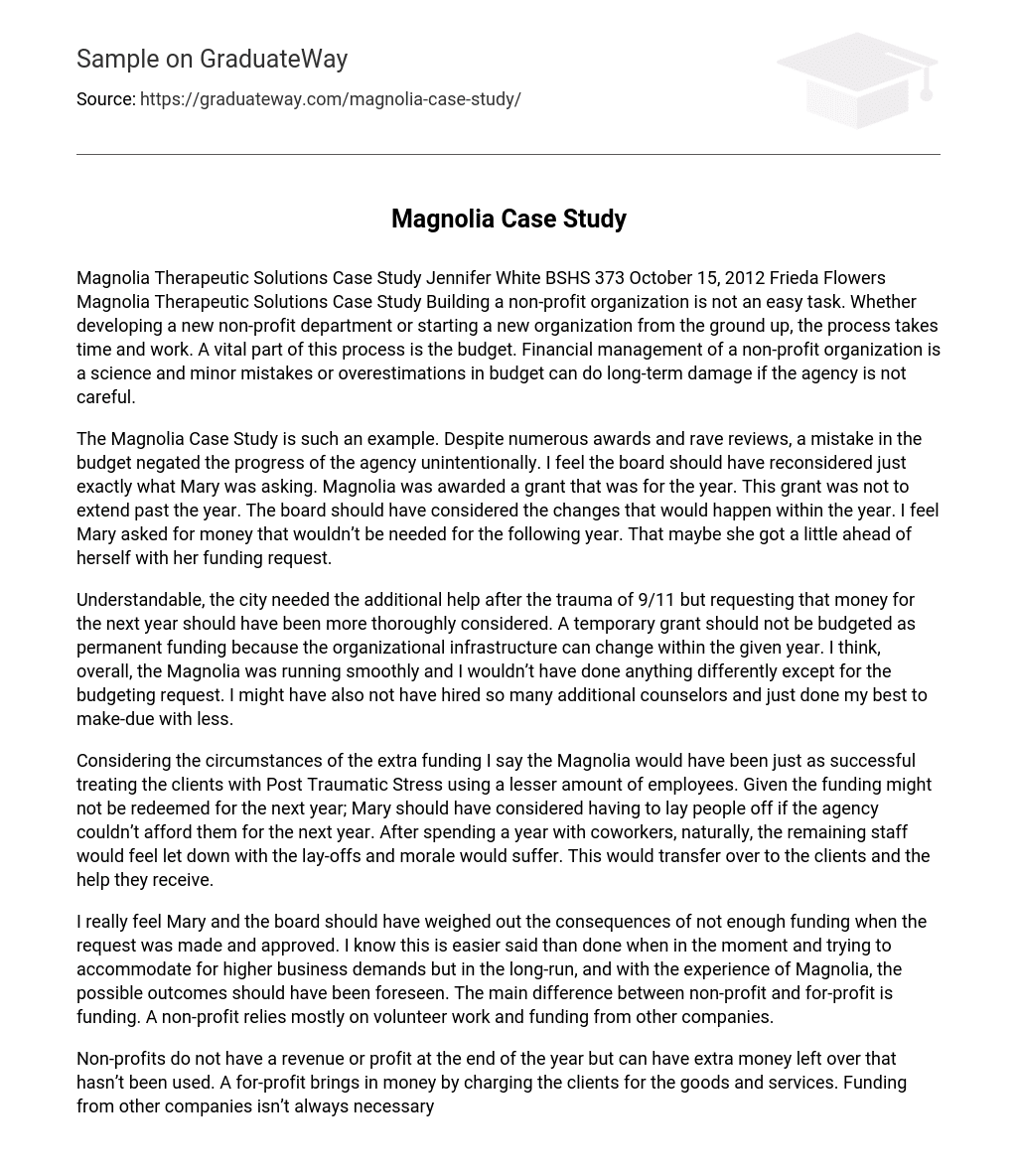Creating a non-profit organization is challenging and involves building a new department or entity from scratch. This undertaking demands substantial time and effort, with the budget being crucial. Managing finances for non-profits is a precise discipline because even minor errors or overestimations in budgeting can result in significant consequences if not handled cautiously.
The Magnolia Case Study serves as an illustration of this situation. Despite receiving numerous awards and positive feedback, an oversight in the budget inadvertently hindered the agency’s progress. In my opinion, the board should have reassessed Mary’s request more carefully. Magnolia was granted funding for a specific year, with no intention of extending it beyond that time frame. The board should have taken into account the changes that would occur within that year. I believe Mary asked for funds that would not be necessary in the subsequent year, suggesting that she may have been overly ambitious in her funding request.
While it was understandable that the city needed extra assistance after 9/11, it should have carefully considered the decision to request funding for the following year. Allocating a temporary grant as permanent funding is not advisable due to potential changes in the organizational infrastructure during that time. Overall, I believe that the Magnolia was functioning efficiently and I would not have made any changes except for reevaluating the budgeting request. Furthermore, instead of hiring many more counselors, I could have tried to manage with fewer resources.
Considering the circumstances of the additional funding, one could argue that Magnolia could have achieved similar success in treating clients with Post Traumatic Stress Disorder by employing a smaller staff. It is important to note that if the funding is not renewed next year, Mary should have anticipated the potential need to lay off employees if the agency cannot afford to keep them. These layoffs would inevitably lead to disappointment and decreased morale among the remaining staff members, ultimately impacting the quality of care for clients.
Mary and the board should have taken into account the possible repercussions of insufficient funding when they first made and approved the request. Even though it was difficult to balance increased business demands, Magnolia’s prior experience should have given them an understanding of potential results. The main difference between non-profit and for-profit organizations lies in their sources of funding, with non-profits relying heavily on volunteer work and external corporate funding.
Non-profit organizations do not generate profit or revenue, but they can accumulate unused funds. In contrast, for-profit businesses earn money by charging customers for goods and services. While for-profit enterprises may not always require external funding due to their paid services, both types of agencies face negative consequences if they have unused services. Non-profits risk losing funding when their services are underutilized, whereas for-profit enterprises would see a decrease in revenue.
To ensure the success of an organization, meeting the community’s needs through their services is crucial. Whether a company is for-profit or nonprofit, they will face challenges if their offerings are not beneficial. Magnolia needs to consider various factors like employee recruitment and safety measures to effectively handle risks. As stated on the National Council of Nonprofits website, scenario planning involves anticipating future opportunities and threats (2012).
Within Magnolia, risk management manifests in various ways. For instance, when an executive director conducts reference checks or verifies the educational background of potential staff, they are actively managing the risk associated with hiring unsuitable individuals. Similarly, the board’s decision to allocate funds to a reserve account or develop a fund development plan serves as a means to address the risk of insufficient cash flow in the future. Additionally, when a client reports an icy patch on the sidewalk and the nonprofit promptly dispatches someone to remove it, they are effectively managing risk. Moreover, risk management extends to training sessions attended by volunteers and board members participating in board orientations. The truth is that risk management opportunities arise in all aspects of daily operations for staff, board members, and program volunteers. In a nonprofit with a strong emphasis on risk management, everyone assumes the role of a risk manager (2012).
Magnolia, similar to other non-profit organizations, failed to realize the significance of budgeting and financial management. This is a typical mistake made by newly established agencies. To establish, secure funding for, and sustain a non-profit organization, one must pay careful attention to minutiae that outsiders may not comprehend. However, if Magnolia recognizes the crucial role budget particulars play in the success or failure of a non-profit organization, it has the potential to recover and thrive in the future.
References
- Magnolia Therapeutic Solutions Case Study National Council of Nonprofits / Risk Management and Insurance. (2012). Retrieved fromhttp://www. councilofnonprofits. org/resources/resources-topic/risk-management-andinsurance





